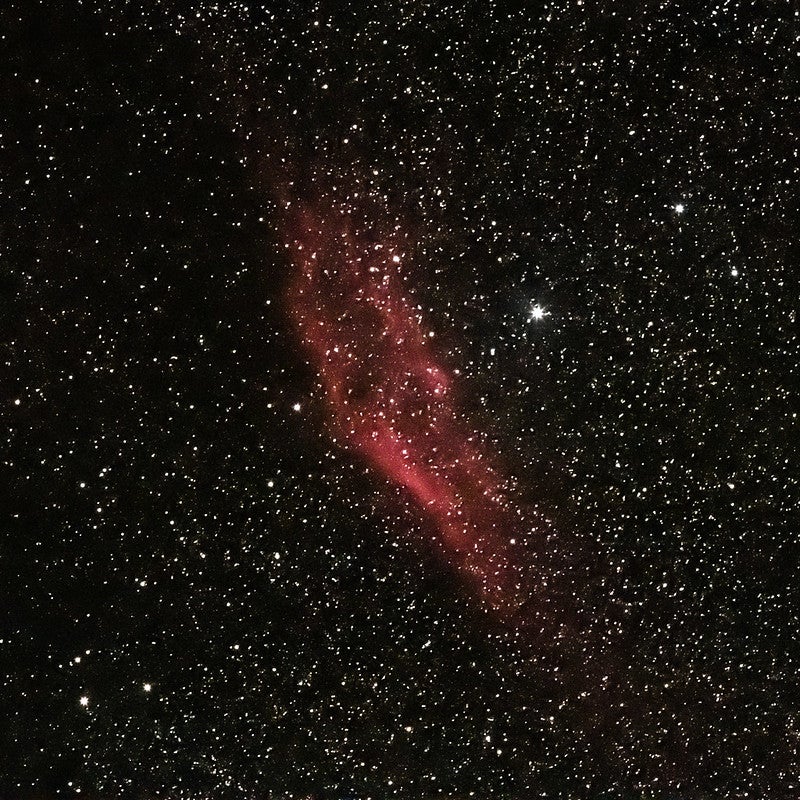
Friday, September 1
A bright gibbous Moon passes 1.4° south of Neptune at 3 A.M. EDT. Evening observers can catch the pair rising within two hours of sunset, now nearly 12° apart — but that will aid in observing Neptune, whose faint, magnitude 7.7 glow will require binoculars or a telescope to pick up.
You’ll find the giant planet to the upper right of the Moon, hanging just beneath the Circlet of Pisces. Neptune is now just 16′ from 5th-magnitude 20 Piscium. You’ll want to check back in on this duo nightly if possible for the next two weeks, as the ice giant treks southwest and passes within 4′ due north of 20 Psc on the 10th. Neptune will reach opposition later this month on the 19th, when it will sit west of 20 Psc. Through a telescope, the planet’s disk now appears 2″ across and may have a slight grayish-blue cast.
If you’re having trouble spotting Neptune tonight with the Moon’s bright light interfering, just wait a few days for our satellite to wane a bit and move along in the sky, then try again. 20 Psc will be your stellar signpost all month.
Sunrise: 6:27 A.M.
Sunset: 7:32 P.M.
Moonrise: 8:42 P.M.
Moonset: 8:13 A.M.
Moon Phase: Waning gibbous (96%)
*Times for sunrise, sunset, moonrise, and moonset are given in local time from 40° N 90° W. The Moon’s illumination is given at 12 P.M. local time from the same location.
Saturday, September 2
Venus stands stationary at midnight EDT, bringing its current retrograde path to an end. Earth’s sister planet rises around 4:30 A.M. local daylight time and stands 10° high an hour before sunrise amid the stars of Cancer the Crab.
The bright planet now shines at magnitude –4.6 and sits about 10° to the lower right (south-southeast) of the loose open cluster M44, also known as the Beehive Cluster. This 4th-magnitude stellar grouping is visible to the naked eye under good conditions and makes a stunning binocular and telescope target. The young cluster spans nearly 100′ on the sky and sits less than 600 light-years away. You won’t be able to catch both in the same telescope or binocular field of view, but astrophotographers aiming for a combination of landscape and sky will certainly capture the pairing in a single shot.
In the coming days, Venus will start sliding east, making a close pass south of magnitude 4.3 Acubens (Alpha [α] Cancri) midmonth. The planet will also brighten to magnitude –4.8, reaching greatest brilliancy on the 9th. Between now and then, you’ll also notice the planet’s appearance changing through a telescope. This morning, Venus is 12 percent lit and spans 49″. By the 9th, its phase will grow to 19 percent lit even as its angular size stretches to 44″ across.
Sunrise: 6:28 A.M.
Sunset: 7:30 P.M.
Moonrise: 9:08 P.M.
Moonset: 9:29 A.M.
Moon Phase: Waning gibbous (90%)
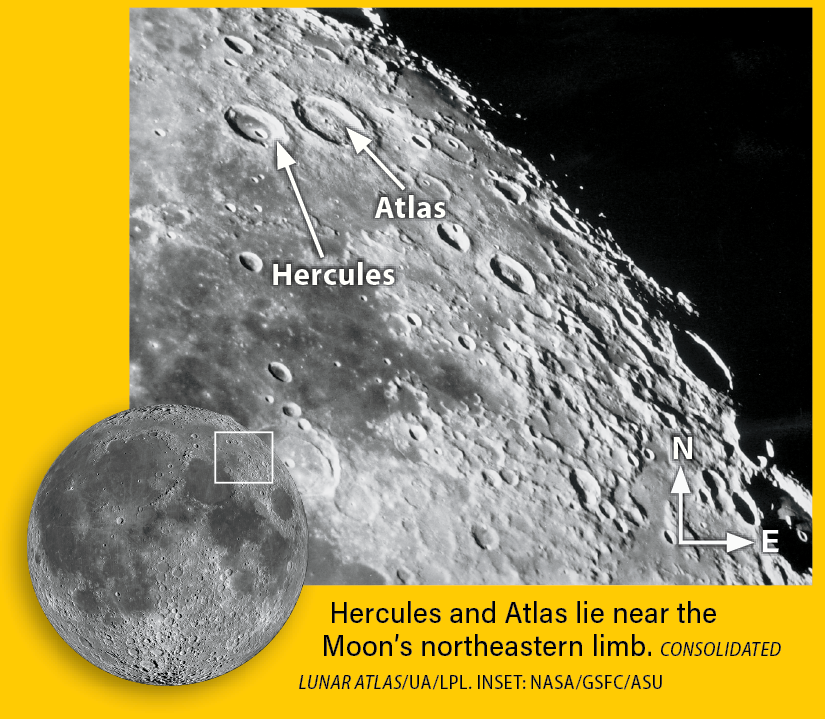
Sunday, September 3
Lunar observers can home in on craters named for two muscle men of myth overnight as the waning Moon rises late and remains in the sky through sunrise.
Point your telescope toward the lunar northeast, where the large, round dark patch of Mare Serenitas (the Sea of Serenity) sits. This region is quickly disappearing into shadow as the Moon wanes toward Last Quarter. See if you can make out the craters Hercules and Atlas on the northeastern rim of Serenity by following our map. Atlas is closer to the limb and thus closer to the sweeping shadow of lunar night as the terminator advances. The floor of Atlas should be bathed in darkness, while Hercules’ bowl remains in the light (for now). Atlas is older than Hercules — do you see how the former’s features are slightly softer, with more wrinkles? These are characteristics of more ancient craters, while younger Hercules remains sharp-edged.
You can catch the pair under opposite conditions — as day breaks across the lunar surface — later this month on the 18th.
Still prominent on the lunar surface is the bright rayed crater Tycho in the south. Take some time to explore this crater and the rugged terrain around it, particularly the larger crater Clavius nearby, which hosts a beautiful curve of craterlets within its walls. Keep watching this region as well to see how it changes as the terminator approaches, and again later in the month when it sweeps past to bring sunrise.
Sunrise: 6:29 A.M.
Sunset: 7:29 P.M.
Moonrise: 9:34 P.M.
Moonset: 10:43 A.M.
Moon Phase: Waning gibbous (82%)
Monday, September 4
Depending on your time zone, you may catch a transit of Io, led by its shadow, across the face of Jupiter either late Sunday night or early this morning.
The planet rises around 10 P.M. local daylight time on Sunday in Aries the Ram, which gains altitude above the horizon with each hour that passes. All four Galilean moons are arrayed to the planet’s east at first, with Io sitting closest. Io’s shadow first appears on the jovian cloud tops just before 1:20 A.M. EDT, when it’s September 4 in the Eastern and Central time zones and still late on the 3rd farther west. The moon itself slowly closes in as its shadow progresses across the planet’s face, reaching just over halfway across by the time Io crosses in front of the eastern limb around 2:30 A.M. EDT on the 4th. Both continue across, with the shadow slipping away around 3:20 A.M. EDT and the moon finally finishing its passage just before 4:40 A.M. EDT.
The other three large moons remain east of the planet. Ganymede is the next farthest out, followed closely by Europa — glance their way as Io progresses and you’ll notice that Ganymede is moving outward in its orbit, while Europa is drawing closer to Jupiter. Shortly after 5:30 A.M. EDT, the two moons pull up even with each other and Ganymede sits 30″ due north of Europa. After that, Europa will sit closer to Jupiter as Ganymede continues to pull away. Callisto, meanwhile, lies farther east.
You may also notice the Moon is nearby this morning; our satellite passes 3° due north of Jupiter at 4 P.M. EDT, an hour before the gas giant stands stationary against the Ram’s stars at 5 P.M. EDT.
Sunrise: 6:30 A.M.
Sunset: 7:27 P.M.
Moonrise: 10:04 P.M.
Moonset: 11:56 A.M.
Moon Phase: Waning gibbous (73%)
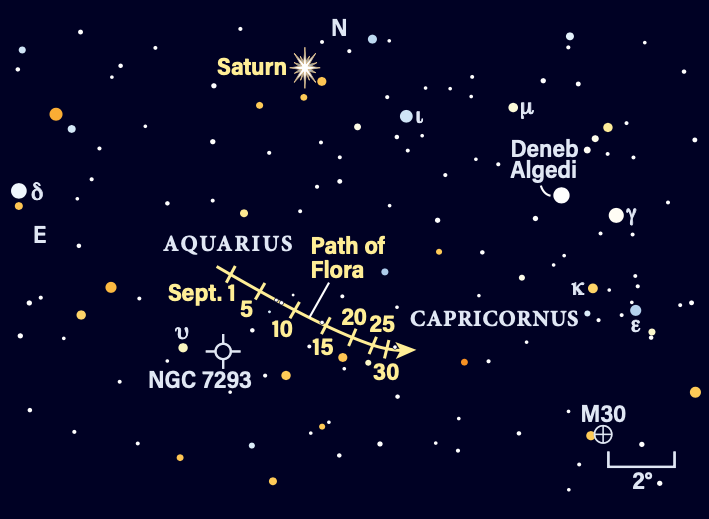
Tuesday, September 5
The Moon continues along the ecliptic, passing 3° north of Uranus at 5 A.M. EDT. But there’s another close encounter in the sky that’s an even better catch: Asteroid 8 Flora poses near the Helix Nebula (NGC 7293) near Saturn in Aquarius. This scene is one you’ll want to view before moonrise, so be ready as the sky starts to truly darken. Two hours after sunset, Saturn is more than 20° high in the southeast. Its magnitude 0.4 light is easy to pick out in the sparse constellation Aquarius.
Center Saturn in your telescope, then drop 7° south to spot Flora’s 8th-magnitude glow. Most of the background stars here are faint and sparse; our finder chart above should help with identification as well. The Helix, a planetary nebula formed by a dying Sun-like star, lies another 2° southeast of Flora — just outside a tight telescopic field of view, but a wide-field eyepiece may do the trick. The nebula’s magnitude is 7.3, but that light is quite spread out, making it faint and hard to catch. That’s why you’ll want to look after twilight and before moonrise, when the background sky will be darkest. Small scopes show the Helix best, so don’t be discouraged if you have a beginner or smaller instrument. Take your time once you’ve found it to try to pull detail out of its fuzzy light. Binoculars will also reveal the planetary nebula quite well, though with less detail than a telescope.
Sunrise: 6:31 A.M.
Sunset: 7:26 P.M.
Moonrise: 10:38 P.M.
Moonset: 1:07 P.M.
Moon Phase: Waning gibbous (63%)
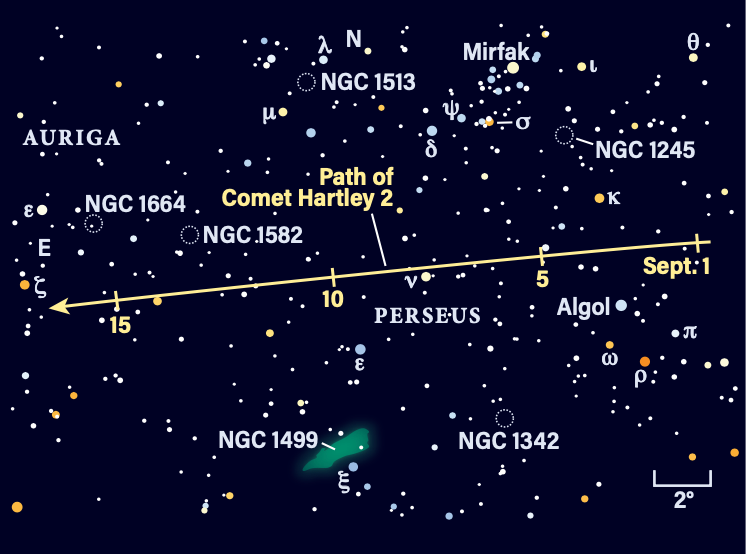
Wednesday, September 6
Mercury reaches inferior conjunction at 7 A.M. EDT. It’s not visible now, but will soon reappear in the morning sky.
Last Quarter Moon occurs at 6:21 P.M. EDT. The Moon rises late tonight, less than an hour before midnight, again giving observers a dark window to chase down a faint target. This time, we’re looking for Comet 103P/Hartley, also called Hartley 2, as it closes in on the star Nu (ν) Persei and the California Nebula (NGC 1499).
Just before or around moonrise, look northeast to find the constellation Perseus to the upper left of the Pleiades star cluster, visible in Taurus. Perseus’ magnitude 1.8 alpha star is Mirfak, but its 2nd-magnitude beta star, Algol, is more famous as the Demon Star whose brightness takes a nosedive to 30 percent of normal every 2.867 days as its binary companion eclipses it.
About 7° east-northeast of Algol is magnitude 3.8 Nu, which is our anchor for tonight. Hartley 2 is passing just 2.5° west of this star. The comet is currently about magnitude 12; images may show its glow as greenish. Nearby, nearly about 6.8° south-southeast of Nu and 8.7° southeast of the comet, is the California Nebula. Wide-field images can capture both at once as the comet moves nearly due east from night to night, passing due north of Nu early on the 8th, when the pair has already set from the eastern half of the U.S., and due north of the nebula two days later.
Sunrise: 6:32 A.M.
Sunset: 7:24 P.M.
Moonrise: 11:19 P.M.
Moonset: 2:15 P.M.
Moon Phase: Waning gibbous (52%)
Thursday, September 7
Look west immediately after sunset and you may be able to pick out Mars in the falling twilight. The Red Planet sits just 5° high 20 minutes after sunset and glows at magnitude 1.7, making it a bit of a challenge. Try using binoculars or a telescope to scan near the western horizon (make sure to wait until the Sun is fully set). As the stars start to appear, look for 1st-magnitude Spica, which lies 17° to Mars’ upper left (east-southeast). Spica is a beautiful blue-white star some 1,900 times brighter than the Sun, though its light comes from not one but two stars (they sit much too close to separate with a backyard instrument).
Closer to Mars is 3rd-magnitude Porrima, just 3.8° northeast of the planet. Once you’ve centered on Porrima, which sets about 15 minutes after Mars, you’ll notice it’s a beautiful double star — unlike Spica, this pair can be split. Its components are nearly identical suns with magnitudes of 3.65 and 3.56. They’re currently about 3″ apart and are on their way to their greatest angular separation of 6″ after coming closest in 2005. However, given their roughly 169-year period, it’ll be a while yet! Mars’ disk appears just 4″ wide, or slightly wider than the space between these two stars.
Sunrise: 6:33 A.M.
Sunset: 7:22 P.M.
Moonrise: —
Moonset: 3:18 P.M.
Moon Phase: Waning crescent (42%)
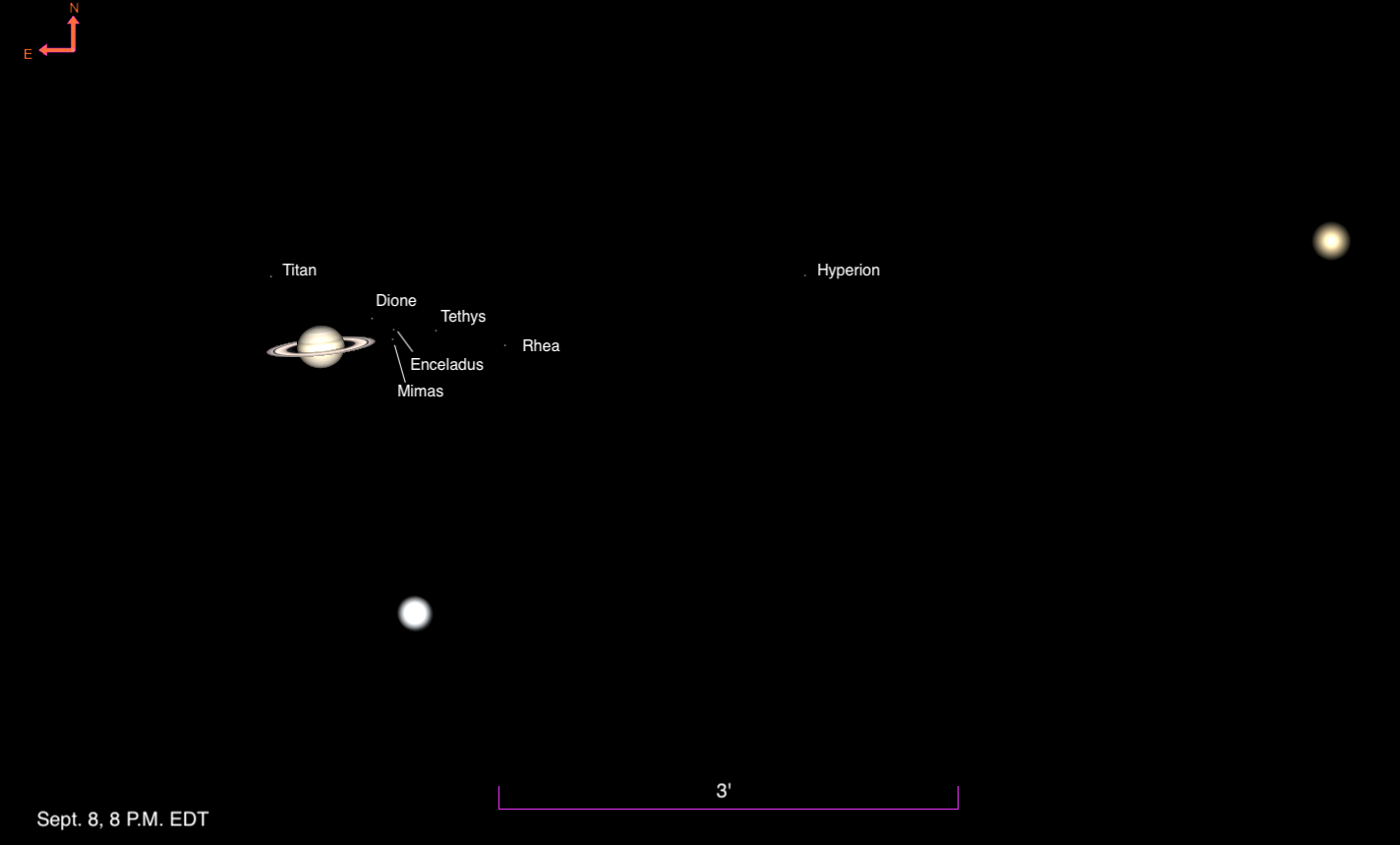
Friday, September 8
Although now past opposition, mighty Saturn remains a worthy evening target. The ringed planet still spans 19″, while its rings stretch a full 42″ across. Saturn is getting farther from Earth as the time after opposition increases, so the view earlier in September is better than later in the month.
Around 10 P.M. EDT, you’ll notice the planet is just 1.5′ due north of a 9th-magnitude field star. Don’t confuse that point of light for Saturn’s largest moon, Titan, just a shade brighter and closer to Saturn tonight, less than an arcminute northeast of the center of the disk. Several smaller, fainter moons lie closer still, huddled on the planet’s western side. Over the course of the night, they’ll start to move east, some (Enceladus and Mimas, and much later Tethys — the last in daylight for much of the U.S.) passing behind it and one (Dione) clearing the north pole as it slides from one side of the disk to the other. Note also that Iapetus (not shown above) lies far west of the planet, some 9.5′ away!
That 9th-magnitude star is not the only interloper: a brighter 8th-magnitude star sits just over 6′ due west of the planet — again, closer to Saturn than Iapetus. Overnight, Saturn will slide southwest, moving nearly in line between these two stars by the time the Sun rises. Careful observation should reveal the planet’s motion relative to these background stars as the hours pass, in addition to the motion of its moons.
It’s also worth noting a third star, also 9th-magnitude, lies 10.5′ east of the planet early in the night (also not shown).
Sunrise: 6:34 A.M.
Sunset: 7:21 P.M.
Moonrise: 12:06 A.M.
Moonset: 4:12 P.M.
Moon Phase: Waning crescent (33%)

Sky This Week is brought to you in part by Celestron.









